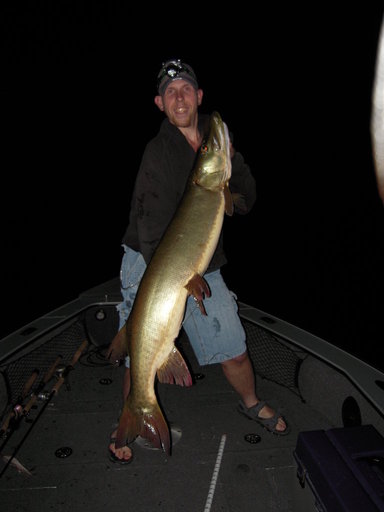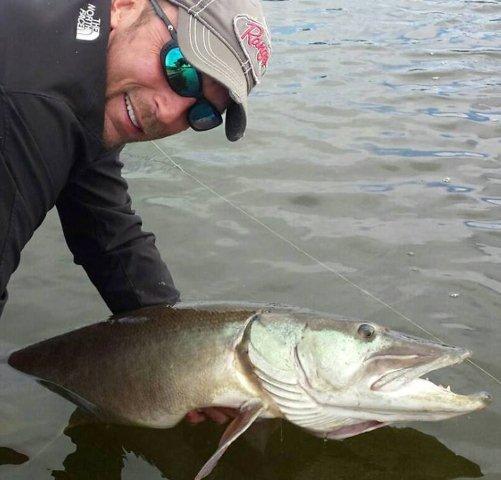|
|
Posts: 410
Location: With my son on the water | I am close to pulling the trigger on one of these, I have read lots of positive reviews. BUT: for some of you guys with the better battery/charger knowledge I have a question.
The Minn Kota DC alternator will send 10 amps to each trolling motor battery after the unit sees 13.7 volts, does supplying a CONTINUOUS 10 amps to each trolling motor battery cause the risk of overcharging or cooking out the trolling motor batteries?
Thanks in advance for your answers and have a great day.
Brad |
|
| |
|

Posts: 347
Location: eagle river,wis | Look at the Stealth unit.I have run them on the last 3 boats and they work fantastic.Charge the batteries when the outboard is running and I seldom have to plug in the ac charger. |
|
| |
|
Posts: 1901
Location: MN | That's not what he was asking but ... I also have a Stealth system and its the greatest thing since sliced bread. I know for a fact that the Stealth unit is not limited to 10 amps, but after the cranking battery gets to 13 (if it gets below that) the juice is then directed to the trolling motor batteries. The trick here is that it allows those batts to take what they need. It doesn't "force" feed them. I'm sure the MinnKota unit has similar tech just offers less charging amps. |
|
| |
|

Location: Not far enough north! | I've been looking into these as well. I've got a tuffy1760 and have been running through all the wiring diagrams on the stealth and since the voltage isn't jumped to 24 volt until the plug on the trolling motor all the wiring in the boat is essentially a 12v system not 24. Did any of you guys put this stealth system into a newer Tuffy? I'd be interested to hear how yours ended up being wired. I talked to Danny the other day and he was very helpful just didn't have the right questions ready when we talked. I will probably be speaking with him more this week but was curious if anyone else dealt with this... |
|
| |
|
Posts: 1901
Location: MN | Been a year since I wired mine on an old Ranger. But mine also is converted to 24v at the plug. It was no problem. Danny gave me the basics, good directions and diagrams came with the unit, and it really is no problem. After I got it hooked up he asked me to call him from the boat so he could have me check a few things while he was on the phone. I love this thing. |
|
| |
|

Posts: 265
Location: Hudson,WI | I ran a Minn Kota DC alternator charger on my Ranger 618VS and I loved it!! I always had charged batteries, and rarely had to plug in the AC charger. I never checked the amperage personally, but I believe that it only allows a charge if one is necessary. I'm having another one installed in my new boat as we speak!! You get a better charge when using DC charging, and it's also better for the life of your battery. |
|
| |
|
Posts: 410
Location: With my son on the water | I got my answer (see below) from one of the better/best battery/charger sources on this site. [Thanks Al]
No, 13.7VDC will not damage your batteries. That voltage is the typical float voltage for a 12V lead acid battery. However, to use the MK-2-D you need a minimum of a 25A alternator on your main engine. The Minnkota is not really a "Alternator", its a charge regulator that takes the DC output of your main engine alternator and redirects it once the main starting battery reaches 13.7VDC. - meaning its also at a safe level for starting your main engine if needed.
My motor has a 60 amp charger, so I ordered it yesterday for $98 shipped. I will probably have to purchase $20 worth of wire, spare fuses, heat shrink, etc, but I am really excited to see how this works.
The main reason I am getting this is because when we are up on LOTW it never fails the power gets knocked out from some big storm and our batteries are not charged.
|
|
| |
|
Posts: 437
| Propster - 5/31/2015 9:26 AM
Been a year since I wired mine on an old Ranger. But mine also is converted to 24v at the plug. It was no problem. Danny gave me the basics, good directions and diagrams came with the unit, and it really is no problem. After I got it hooked up he asked me to call him from the boat so he could have me check a few things while he was on the phone. I love this thing. I had the same type of wiring set up as Propster and installed my Stealth last year as well.
Works great! Absolutely love the thing.
The MinnKota is also a very good unit, I mainly bought the Stealth because if something should happen, its rebuildable, not throwaway.
As a side note, when buying a Stealth from Danny (who rocks BTW) if you tell him exactly how far your wire runs are, he will send you all the wire you should need and at the correct lengths. It is high quality marine grade wire too.
Unfortunately for me I made a couple mistakes when measuring so it didn't quite work perfectly for me and I had to buy one length of wire, but still it was great.
At any rate, a DC alternator charger is something I will have on every boat from now on. For me it will be a Stealth because I am just so impressed with the thing. |
|
| |
|

Location: Contrarian Island | I put one in 2 yrs ago and have been very impressed and would not want to me on a big lake / trip like LOTW without one... never have to worry about battery life at the end of a long 15 hour day on the water! |
|
| |
|
Posts: 437
| BNelson - 6/1/2015 10:11 AM
I put one in 2 yrs ago and have been very impressed and would not want to me on a big lake / trip like LOTW without one... never have to worry about battery life at the end of a long 15 hour day on the water! Precisely! This is exactly what I found out last year when on LOTW for a week with NO access to electricity other than a portable generator. I never used the generator during the trip and never had issues with my trolling motor batteries. When running from spot to spot its several miles and that was enough to keep the batteries close to 100%. The lowest I had seen on the batteries was like 70%.
The other boat charged his batteries twice. Which isn't a big deal but it sure was nice not to need to.
He ended up buying one for his boat after seeing my experience. |
|
| |
|
Posts: 134
| I have used both (Stealth and MinnKota) There was an issue with the stealth and it caused a short and small fire while fishing LOTW (thank god for a working fire extinguisher. Worked great until that point. Replaced with a MinnKota and has worked just as well. Full day on the water I can't tell the difference. I do miss the gauge that the Stealth had but, after the experience I'll stick with the Minnkota, Just put a new one in the new boat, will put one in the next. |
|
| |
|
Posts: 14
| I am researching the Minnkota MK-2 for my boat too. I have confirmed my main motor alternator to be 25 amp capacity, but my T8 kicker is only has a 6 amp alternator. Anyone know if the charger will still work with my kicker running or could I potentially cause damage to the alternator of my T8?
BENT |
|
| |
|
Posts: 437
| No, you shouldn't cause damage to the alternator of your kicker, but I don't believe it will actually charge your trolling motors at all when using the kicker if that is what you are asking. |
|
| |
|

Posts: 5874
| You can't force current into a battery, if it's at full charge. The charger will only put out what the battery can handle. Same with an alternator on your car. It's rated for 70A, or 130A, but it's not always pumping that into the battery. |
|
| |
|
Posts: 51
| Not real sharp on Electronics, and seem to always have some sort of electrical issue.
(Never had a radio last a season for instance). So this may be a dumb question.
I understand the dependence on size of engine a"alternator" AMP out put (ie 25 mp).
Does this also then depend on the engine rpms being high to generate that amperage of 25 at high rpm as opposed to 1/3 throttle.
It has been my understanding that a car's max amp out put is reached anywhere from a mere idle to high rpms but an out board motor's amp output is dependent on rpms with out put increasing only as rpms increase towards max.
If so would short runs from spot to spot or travel at 1/2 - 3/4 throttle negate the need for these units or do you think they would still be worth it.
|
|
| |
|
Posts: 1901
Location: MN | I believe with most motors you are correct, the rpm's have to be up enough to generate enough amps to charge the batteries. So what you are asking is yes, short runs at something above idle will probably be charging. So not a matter of it working. I think what you're really asking though is whether on smaller bodies of water whether there will be enough of these short runs to help much. I don't think anyone can answer that completely but I'm quite certain that it will assist somewhat even if it is simply charging the batteries back up a little on the run back to the access, putting a little charge in them in case you can't get to electricity and a standard charger for a bit. |
|
| |
|
Posts: 437
| M Ruff - 6/3/2015 9:46 PM
I understand the dependence on size of engine a"alternator" AMP out put (ie 25 mp).
Does this also then depend on the engine rpms being high to generate that amperage of 25 at high rpm as opposed to 1/3 throttle.
If so would short runs from spot to spot or travel at 1/2 - 3/4 throttle negate the need for these units or do you think they would still be worth it.
Most larger motors these days have alternators the generate in excess of 40 AMPs peak and the close of all of that is available just over idle speed. I can speak from experience with my Stealth DC unit that when idling (and once the cranking battery has reached desired voltage) that I do not see significant charging being done to the trolling batteries. This is easy to tell by having the digital gauge. If the batteries read roughly 25 volts (in a 24 volt system) they are at a steady state, but when that number is climbing into the upper 25 to 27.8 volts then they are being charged by the DC charger.
So, I guess in a wordy way if all you do is short little bursts from spot to spot and you use your trolling motors extensively while fishing a spot you will see little benefit from a DC charger regardless of what brand they are. It may help a bit, but it may not be enough to avoid needing to plug in at the end of the day.
My experience after using one for an entire season and spending a week on LOW proved that with runs between spots of a couple miles was more than sufficient to achieve sufficient replenishment of the amperage used during the trolling motors usage.
I am a big fan of these types of systems, but for someone who fishes small lakes I don't think they would really see the benefit as much as someone who fishes large lakes. |
|
| |
 Minn Kota DC alternator?
Minn Kota DC alternator? Minn Kota DC alternator?
Minn Kota DC alternator?